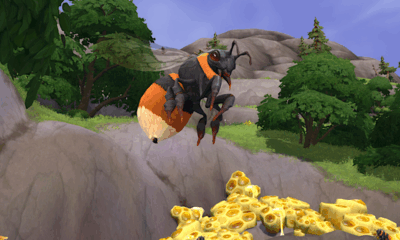Science
Edmonton Study Reveals Hidden Dangers of Urban Coyotes

Research led by Colleen Cassady St. Clair has uncovered new insights into the behaviour of coyotes in urban settings, highlighting both their adaptability and potential health risks. Initiated in 2009, the Edmonton Urban Coyote Project aimed to understand the increasing frequency of coyote sightings in residential areas of Edmonton. St. Clair, a professor in the Faculty of Science, collaborated with the City of Edmonton and Animal Damage Control to investigate the sources of human-wildlife conflict and develop strategies for coexistence.
St. Clair noted that coyotes are increasingly found in urban environments, often in areas previously considered off-limits. To address this, the project implemented a community-based hazing program designed to educate residents on how to encourage coyotes to be more cautious around humans. “Coyotes are a really interesting example of an animal that adapts well to urban living,” St. Clair explained. “By studying them, we can learn how to mitigate conflicts and gather insights beneficial for the conservation of other species.”
The hazing technique involves making loud noises and using objects to scare coyotes away. St. Clair emphasized that frequent hazing is necessary for effectiveness, allowing coyotes to generalize their experiences and become more wary of humans. To cover the extensive area of Edmonton, the project recruited 120 volunteers from 71 neighbourhoods, who logged over 1,300 hours of observation during two four-month field seasons.
Volunteers were trained to identify “bold” coyotes, defined as those that allowed humans to approach within 40 metres. They were equipped with sand-weighted tennis balls and distance-measuring cards to facilitate the hazing process. Despite the extensive surveillance, only 175 coyote sightings were reported, indicating that close encounters are less common than perceived. Over the two-year period, only 23 coyotes qualified for hazing, demonstrating that most encounters resulted in the coyotes leaving the area when confronted with the distance-measuring card.
The study also highlighted a significant health risk associated with urban coyotes. St. Clair warned about the presence of a dangerous strain of tapeworm known as Echinococcus multilocularis, which has mutated since its introduction from Europe. This parasite can be fatal if not detected early, and 35 Albertans have been diagnosed over the past twelve years. Coyotes shed microscopic eggs in their droppings, which can spread through wind, water, and animal interactions. Approximately 65 percent of tested coyotes in Edmonton were positive for this parasite, raising concerns about their presence in areas frequented by children and pets.
The goal of the Edmonton Urban Coyote Project is not to eliminate coyotes but to encourage a safer coexistence. St. Clair believes that it is feasible to reduce coyote presence in high-traffic areas while still allowing them to thrive in less populated regions. Although the initial hazing study has concluded, St. Clair continues to advocate for community involvement in hazing efforts.
In collaboration with the City of Edmonton, a new high-intensity hazing program has been initiated, targeting areas with ongoing coyote issues. Additionally, Sage Raymond, a PhD student under St. Clair’s supervision, is researching coyote cognition to better understand how these animals overcome their natural fear of humans, which could inform future management strategies.
Residents are encouraged to remain vigilant and apply hazing techniques when coyotes are spotted in residential areas. Through community engagement and ongoing research, the Edmonton Urban Coyote Project aims to foster a safer environment for both humans and wildlife.
-

 Education3 months ago
Education3 months agoBrandon University’s Failed $5 Million Project Sparks Oversight Review
-

 Science4 months ago
Science4 months agoMicrosoft Confirms U.S. Law Overrules Canadian Data Sovereignty
-

 Lifestyle3 months ago
Lifestyle3 months agoWinnipeg Celebrates Culinary Creativity During Le Burger Week 2025
-

 Health4 months ago
Health4 months agoMontreal’s Groupe Marcelle Leads Canadian Cosmetic Industry Growth
-

 Science4 months ago
Science4 months agoTech Innovator Amandipp Singh Transforms Hiring for Disabled
-

 Technology4 months ago
Technology4 months agoDragon Ball: Sparking! Zero Launching on Switch and Switch 2 This November
-

 Education4 months ago
Education4 months agoRed River College Launches New Programs to Address Industry Needs
-

 Technology4 months ago
Technology4 months agoGoogle Pixel 10 Pro Fold Specs Unveiled Ahead of Launch
-

 Business3 months ago
Business3 months agoRocket Lab Reports Strong Q2 2025 Revenue Growth and Future Plans
-

 Technology2 months ago
Technology2 months agoDiscord Faces Serious Security Breach Affecting Millions
-

 Education4 months ago
Education4 months agoAlberta Teachers’ Strike: Potential Impacts on Students and Families
-

 Education3 months ago
Education3 months agoNew SĆIȺNEW̱ SṮEȽIṮḴEȽ Elementary Opens in Langford for 2025/2026 Year
-

 Science4 months ago
Science4 months agoChina’s Wukong Spacesuit Sets New Standard for AI in Space
-

 Business4 months ago
Business4 months agoBNA Brewing to Open New Bowling Alley in Downtown Penticton
-

 Business4 months ago
Business4 months agoNew Estimates Reveal ChatGPT-5 Energy Use Could Soar
-

 Technology4 months ago
Technology4 months agoWorld of Warcraft Players Buzz Over 19-Quest Bee Challenge
-

 Business4 months ago
Business4 months agoDawson City Residents Rally Around Buy Canadian Movement
-

 Technology4 months ago
Technology4 months agoFuture Entertainment Launches DDoD with Gameplay Trailer Showcase
-

 Technology2 months ago
Technology2 months agoHuawei MatePad 12X Redefines Tablet Experience for Professionals
-

 Top Stories3 months ago
Top Stories3 months agoBlue Jays Shift José Berríos to Bullpen Ahead of Playoffs
-

 Technology4 months ago
Technology4 months agoGlobal Launch of Ragnarok M: Classic Set for September 3, 2025
-

 Technology4 months ago
Technology4 months agoInnovative 140W GaN Travel Adapter Combines Power and Convenience
-

 Science4 months ago
Science4 months agoXi Labs Innovates with New AI Operating System Set for 2025 Launch
-

 Technology4 months ago
Technology4 months agoNew IDR01 Smart Ring Offers Advanced Sports Tracking for $169










